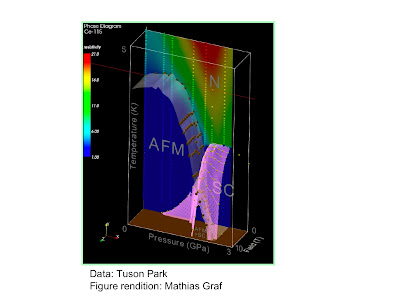
Joe described his work with T. Park and other collaborators on CeRhIn5,
a member of the 115-family of heavy fermion materials that are layered
derivatives of the cubic CeIn3. The attached figure shows the
magnetic/superconducting phase diagram as a function of pressure,
magnetic field, and temperature.
At a sufficiently high magnetic field (above 9T), increasing pressure
induces a quantum phase transition (at P1) from an antiferromagnetic metal
phase to a non-magnetic metal phase. There is some indication that
the transition is second order. Yet, dHvA measurements of Onuki's group
find a jump in the Fermi surface, with effective mass showing a tendency
of divergence at P1. In the low-pressure AF phase, the f-electrons are
localized since the measured Fermi surface is similar to that seen
in the f-less reference material LaRhIn5. In the higher-pressure non-magnetic
phase, on the other hand, the same f-electrons are itinerant because
the measured Fermi surface is similar to that of the bandstructure
calculations in which these f-electrons are assumed mobile.
Joe went on to describe the pressure-induced transitions inside the
superconducting part of the phase diagram. For finite fields (which
are smaller than 9T), there is evidence for the second-order nature
of the transition from a co-existing AF+SC phase (which appears to
be homogeneous) to a pure SC phase. At H=0, the residual specific
heat coefficient was found to undergo a rapid decrease as the pressure
is increased through a threshold value (P2, smaller than P1),
as did the Fermi velocity fitted from the finite-T Hc2.
Joe suggested that the f-electrons remain localized in the SC+AF
phase. He did so based on the aforementioned dHvA observation
of localized f-electrons in the high field AF state, along with
the observation that the ordered moment at temperatures just above
Tc of the AF+SC phase is large.
There was discussion about how strong an evidence the above entail
for the localized nature of the f-electrons inside the AF+SC phase.
There was also discussion on the extent to which the change of \gamma
and v_F across P2 should be associated with the transition in magnetism,
or is instead a reflection of a distinction in superconductivity between
the co-existing AF+SC phase and the pure SC one.
Joe went on to describe the effect of Cd-doping in Co-115 and Ir-115.
A co-existing AF+SC region occurs in the Cd-doped Co-115, but is absent
in the Cd-doped Ir-115.
The main questions that Joe raised are:
* What is the nature of the 4f electrons when they participate
simultaneously in magnetism and superconductivity?
* If we accept the notion that the f-electrons are localized while
participating in the superconductivity, what implications does it
have for the non-Fermi liquid behavior in the normal state?
* In particular, does it suggest some form of Kondo breakdown?
Friday, August 3, 2007
Joe Thompson: "Proximity of Superconductivity and Magnetism in the 115s"
Posted by
Qimiao
at
1:14 PM
![]()
Subscribe to:
Post Comments (Atom)

3 comments:
Winter Reflections by Cindy Costa via +Laurence Pegard
It doesn't get much prettier than this. The whole scene is perfect.
From the reflections on the water to the carved cliffs, beautiful.
Thanks for sharing Laurence.
escort sydneyprodutos eroticos
March 2nd could be shaping up to be a hot day for Canon fans. Maybe...
p spot stimulatorsLesbiskt porrfilm
Joe described his work in a professional manner! God bless him! This article can become a great addition to my custom paper!The whole scene is perfect
Post a Comment